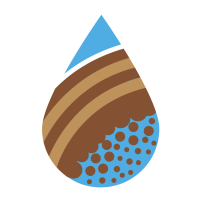
Erosion Types and Causes
Erosion feature: Peat hags / gullies
What does it look like?
Gullies are channels cut through peatland usually by water. Hags are the isolated mounds of vegetated peat often left between the gullies. (see selection of photos of gullies and hags)
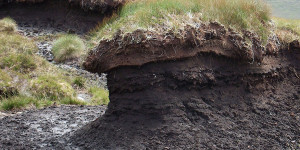
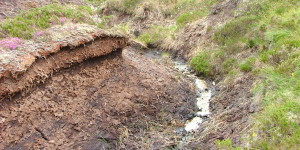
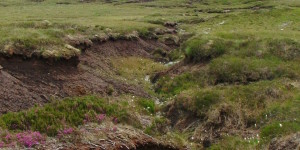
Where do you find it?
In areas of peatland, mostly in the uplands.
What causes it?
Peat erosion starts with the loss of vegetation covering the peat. Vegetation can be damaged by natural processes which can be made worse by inappropriate land management practices such as unsuitable draining or burning of the land, trampling by animals and people and by pollution. The unprotected peat is then exposed to the weather (wind and rain). Moving water can form channels in the peat, resulting in a very characteristic landscape of gullies running downslope. Peat hags - isolated mounds of vegetated peat remaining between the gullies - are a typical feature of these landscapes. Exposed peat can also dry out and blow away.
Erosion feature: Rill / gully
What does it look like?
Rills and gullies are channels cut into the land. The main difference between them is their size:
They can occur in straight lines if they form in tractor wheel tracks (tram lines), or in a branch pattern if they have no obvious lines to follow.
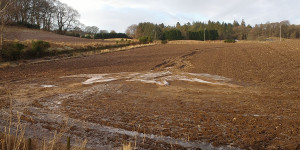
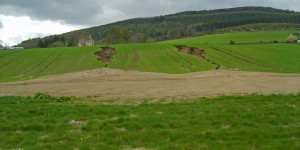
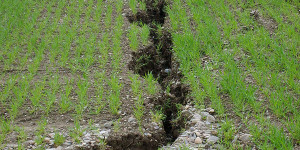
Where do you find it?
Most often on slopes in bare or recently cultivated fields.
What causes it?
Rills and gullies form where water collects and flows in narrow channels down a slope, taking the soil with it.
What happens to the soil?
The soil washed out of rills and gullies:
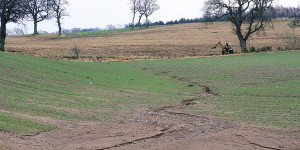
Erosion feature: Path / track erosion
What does it look like?
Eroded paths and tracks can be very muddy or hard packed, very deep or very wide, and highly visible from a distance. They can be unpleasant to walk on.
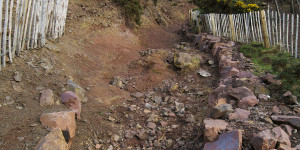
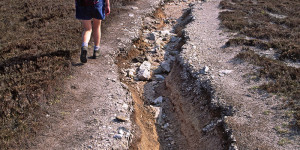
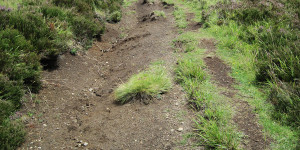
Where do you find it?
Paths and tracks are eroded by sheer numbers of people walking / cycling / riding on them. So, areas around popular beauty spots, viewpoints, hills and car parks are particularly at risk.
What causes it?
People walking, cycling, driving or riding as well as animals grazing and trampling can all damage vegetation. Over time, the mat of vegetation and roots which hold the soils together can break up. The soil can then be easily washed or blown away. As more damage occurs, people tend to try and avoid it by walking on the sides of the path, widening it and increasing the area of erosion. The path may also become more likely to act as a channel for water, which can deepen it.
Erosion feature: Wind erosion
What does it look like?
Banks of soil against walls and hedges, or even as drifts across roads.
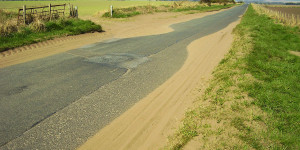
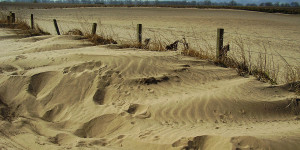
Where do you find it?
Most commonly on bare, dry soils, especially on those wih fine, smooth seedbeds. The soil is often deposited at the edges of fields against walls and hedges or found as drifts - like snow. The finer soil particles can travel long distances in the wind.
What causes it?
Wind erosion occurs when the wind reaches a certin speed and detaches soil particles and transports them across the land surface. Dry soils with fine sandy textures and with fine seedbeds are the most vulnerable.
Erosion feature: River bank erosion
What does it look like?
Damage to the bank of a river or stream.
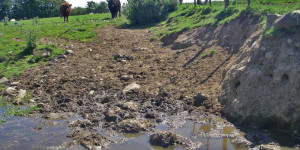
Where do you find it?
On the banks of rivers and streams.
What causes it?
Rivers in their natural state can often change direction and erode their banks. However, bank erosion can also be caused by vehicles, trampling by animals or people, or by farming too close to the edge of the water. Poorly constructed drain outlets can also cause bank erosion.
We hope that you find our Soil erosion app useful. Please let us know by sending feedback to jhiapps@hutton.ac.uk.